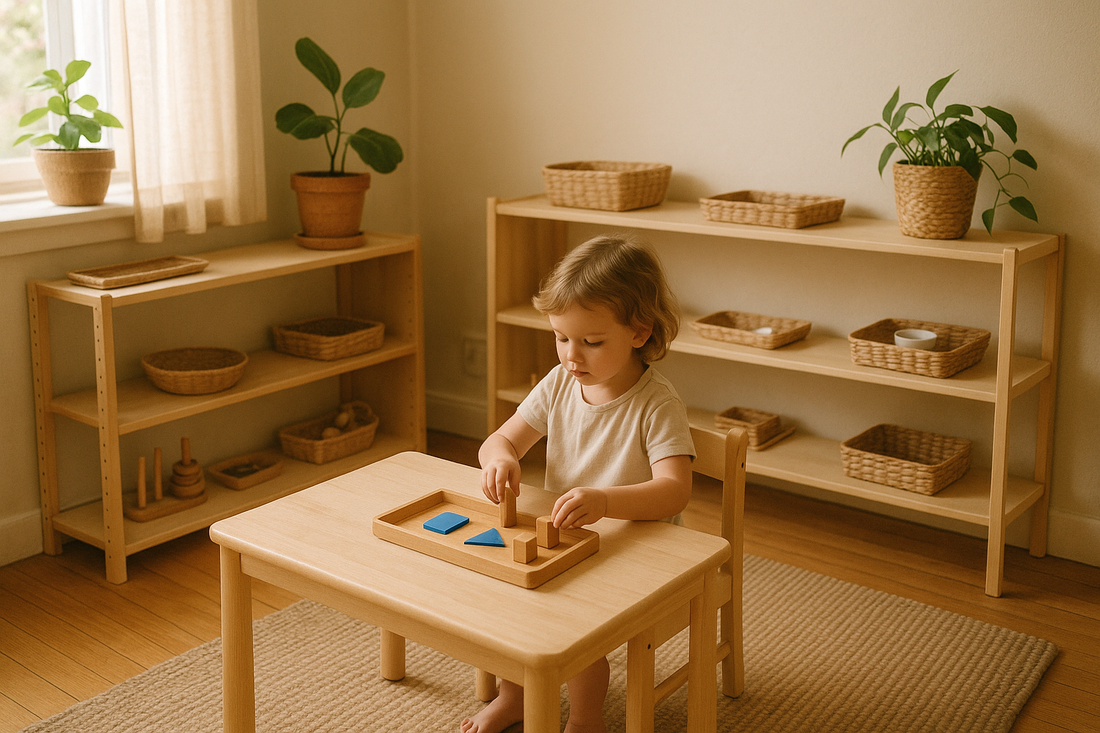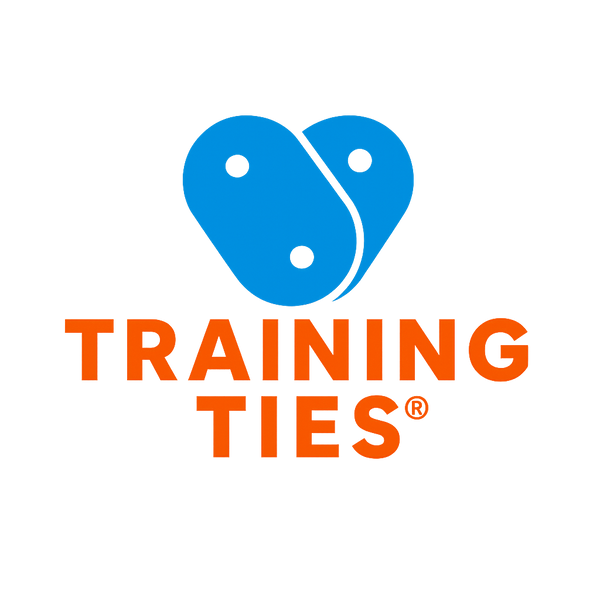
The Prepared Home: Why Your Kitchen Stool Matters More Than Your Curriculum
Share
This morning, I watched my 3-year-old make scrambled eggs.
Not pretend eggs. Not play kitchen eggs. Real eggs that we ate for breakfast.
She cracked them (shells fished out). She whisked them (milk everywhere). She stood on her learning tower at the stove, spatula in hand, tongue out in concentration, and scrambled them (only slightly brown).
When she placed that plate of slightly-too-dry eggs in front of her baby brother and announced, "I made breakfast for our family," I saw something Maria Montessori wrote about over 100 years ago:
"Joy, feeling one's own value, being appreciated and loved by others, feeling useful and capable of production are all factors of enormous value for the human soul."
She didn't just make eggs. She contributed. She belonged. She mattered.
And it all started with a kitchen stool.
The Environment is the Third Teacher
Every Montessori homeschool parent knows the phrase, but here's what it really means:
First teacher: You
Second teacher: The child's own inner guide
Third teacher: The environment itself
Most of us focus obsessively on the first two. We read every Montessori book. We observe our children carefully. We present lessons perfectly.
But we forget that the environment is teaching our children 24 hours a day, whether we designed it intentionally or not.
Your home is constantly whispering to your child:
- "You belong here" or "This is for adults"
- "You're capable" or "You need help"
- "Your work matters" or "Stay out of the way"
The question isn't whether your environment is teaching. It's WHAT it's teaching.
The Great Montessori Misconception
Let's address the elephant in the perfectly-organized shelf:
You don't need a Pinterest-perfect Montessori room.
In fact, Maria Montessori would probably be horrified by our Instagram-worthy shelves with their $200 wooden toys arranged just so.
She worked with orphans. In tenements. With found materials.
What made it Montessori wasn't the aesthetic—it was the accessibility.
Here's what actually matters:
The Five Pillars of a Prepared Home
1. Everything at Their Height Not just toys. LIFE. Towels they can reach. Cups they can get. Clothes they can choose. A spot at the sink where they can wash their hands without asking.
2. Real Over Replica A real banana to slice beats a wooden banana every time. A actual mop (child-sized) over a toy one. Glass dishes (yes, glass) instead of plastic.
3. Incomplete Tasks Everywhere Plants that need water. Mirrors that need wiping. Shoes that need arranging. Work that needs doing. Purpose that needs fulfilling.
4. Breakable Boundaries Things that can spill. Items that can break. Mistakes that can happen. Because that's how careful develops.
5. Beautiful Simplicity Not expensive. Beautiful. A single flower in a tiny vase. Organized drawers. Clear surfaces. Peace that invites concentration.
The Rooms Nobody Talks About
Everyone obsesses over the playroom shelves. But real Montessori happens in the forgotten spaces:
The Bathroom Revolution
Forget the learning tower at the kitchen sink. The bathroom is where independence blooms.
What to add:
- A low mirror at their eye level (IKEA, $5)
- A small pitcher for water
- Their own wash cloth on a low hook
- A basket with their toiletries
- A step stool that lives there permanently
Watch what happens when a 2-year-old can wash their own face whenever they want. It's not about the face washing. It's about ownership of their own body.
The Entryway Transformation
This 3x3 foot space might be the most important in your home.
The setup:
- Low hooks at their shoulder height
- A basket for outdoor things
- A small bench or stool
- A mirror at their level
- A place for THEIR shoes (not family shoes)
When children can manage their own coming and going, they stop being passengers in their own life.
The Kitchen Partnership
Not a learning tower. A partnership station.
The essentials:
- One low drawer with their dishes
- One accessible shelf with their snacks
- A specific spot for their water pitcher
- Their own cutting board and tools
- A low cupboard with cleaning supplies (child-safe)
The message: "This is OUR kitchen, not MY kitchen you're allowed in."
The Montessori Hack That Changes Everything
Ready for the simplest, most powerful change you can make?
Put everything on trays.
Everything.
- Snack preparation? Tray.
- Plant watering? Tray.
- Polishing work? Tray.
- Art supplies? Tray.
- Hair brushing? Tray.
Here's why this works:
A tray creates a complete cycle. Beginning (taking the tray). Middle (doing the work). End (returning the tray).
It makes any surface a workspace. It defines boundaries. It creates order from chaos.
And most importantly: It says "this is a complete work" not "here's some random stuff."
We have 15 trays in rotation. They cost $3 each at the thrift store. They revolutionized our home.
Age-by-Age Environment Evolution
Your prepared environment should grow with your child:
12-24 Months: The Explorer's Environment
- Maximum 6-8 activities available
- Everything about movement and sensory
- Baskets over shelves (easier to access)
- Nothing they can't touch
Focus: Can they access it independently?
2-3 Years: The "I Do It Myself" Environment
- 8-10 activities rotating weekly
- Practical life takes center stage
- Real tools, real work
- Lots of transfers, pouring, scooping
Focus: Does it build real skills?
3-4 Years: The Competent Contributor Environment
- 10-12 activities plus daily life access
- Care of environment becomes crucial
- More complex, multi-step works
- Beginning academic materials if interested
Focus: Can they contribute to family life?
4-6 Years: The Capable Citizen Environment
- Open access to most materials
- They help choose what goes on shelves
- Real responsibilities (pet care, plant care, meal prep)
- Academic work self-selected
Focus: Do they own their environment?
The Sacred "Yes" Space
Here's what exhausts Montessori parents:
Constant vigilance. Constant redirection. Constant "no."
You know what Maria Montessori never said? "Follow the child around saying 'be careful' all day."
Instead, create a YES space. One room (or even one corner) where everything is:
- Safe to touch
- Okay to move
- Fine to explore
- Impossible to "mess up"
Then—and this is crucial—LEAVE THEM ALONE IN IT.
Not unsupervised. Uninterrupted.
The deep concentration Montessori wrote about? It only happens when children feel completely safe to explore without intervention.
The Rotation Reality Check
Everyone talks about toy rotation. Nobody talks about the emotional labor involved.
Here's the truth: You don't need to rotate if you don't have too much.
Instead of 30 activities rotating through 10 shelf spaces, what if you just had... 10 activities?
Quality over quantity. Depth over breadth. Mastery over novelty.
That block set they've had since age 2? They're still discovering new things at age 5—if it's the only block set.
That transferring work with beans? It becomes pouring, then sorting, then counting, then patterning—if it has space to evolve.
Stop rotating. Start observing. Let works deepen instead of disappear.
When the Environment Isn't Working
Signs your environment needs adjustment:
They're not choosing work:
- Too many choices? Reduce by half.
- Too difficult? Add simpler options.
- Too easy? Add challenge.
They're destructive:
- Not enough YES space.
- Need more gross motor options.
- Environment says "don't touch" too often.
They won't clean up:
- No defined places for things.
- Too many items for the space.
- Cleanup feels like punishment, not completion.
They always need entertainment:
- Environment isn't engaging.
- Works aren't at their developmental level.
- Too much passive consumption available.
The Invisible Preparation
Here's what nobody tells you about the prepared environment:
The most important preparation is invisible.
It's the work you do at 9 PM, setting up tomorrow's bread-making materials.
It's the Sunday evening shelf refresh based on what you observed that week.
It's moving the stool to the counter before they ask.
It's filling the water pitcher before they're thirsty.
It's the thousand tiny adjustments that say: "I see you. I prepared for you. You were expected here."
Because that's what the prepared environment really is—a love letter to your child that says:
"This space was waiting for exactly you."
The Mindset Shift That Changes Everything
Stop preparing your home for the child you wish you had.
Prepare it for the child you actually have.
The one who loves dinosaurs, not butterflies. The one who wants to cut vegetables, not arrange flowers. The one who needs to move, not sit still.
Your prepared environment should be a portrait of your actual child, not a Montessori catalog.
Because here's the secret:
Montessori isn't about the materials. It's about the match.
The perfect match between your child's developmental needs and their environment's offerings.
Get that right, and everything else follows.
Start Here Today
Feeling overwhelmed? Start with this:
Pick one surface in your home.
Just one. Maybe the bathroom sink. Maybe a kitchen counter. Maybe an entryway bench.
Make it theirs.
Lower it, clear it, simplify it, beautify it. Put their things there. Only their things. At their height. For their hands.
Then watch.
Watch how they interact with that one prepared space. Watch how it changes their movement through your home. Watch how it changes their relationship with independence.
That one surface will teach you more about the prepared environment than any book or course.
Because you'll see it through their eyes.
And suddenly, you'll understand what Maria Montessori understood:
The environment isn't just where learning happens.
The environment IS the learning.
From our family to yours—may your home whisper "you are capable" in every corner.
